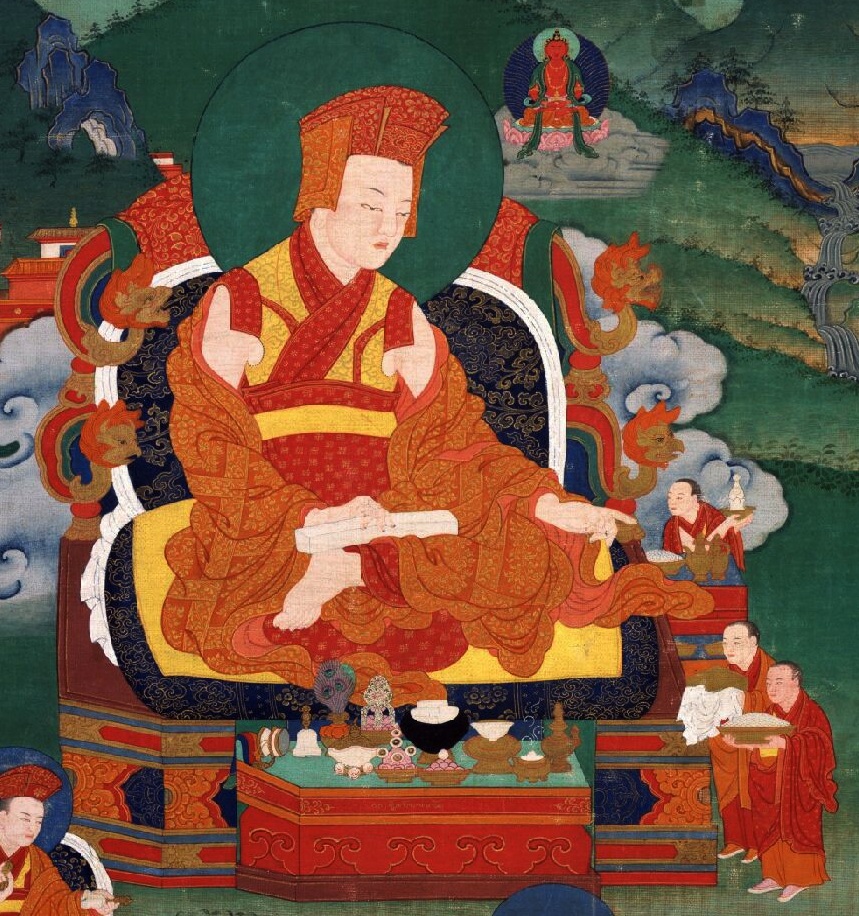September 15, 2016 – 1:13 am | Permalink |
by Russell Rodgers

Grant your blessings so that my mind may be one with the dharma.
Grant your blessings so that dharma may progress along the path.
Grant your blessings so that the path may clarify confusion.
Grant your blessings so that confusion may dawn as wisdom.
The author of these lines, Gampopa, lived at a very critical time in the birth of our lineage and helped shape its future in profound ways. After his birth in 1079, Gampopa displayed much curiosity and openness to the dharma, and received teachings from many gurus. He was also very interested in medicine, and eventually became a physician. Gampopa married, and he and his wife were very much in love. When he was 24, she became terminally ill. Gampopa was unable to help her, despite his medical training. Moreover, she experienced great pain and suffering, and according to Khenpo Karthar Rinpoche, was unable to experience her death properly. Gampopa asked her why this was and she replied, “I am not attached to possessions, nor wealth, nor faith, but I am very attached to you. Because you are only 24 years old, and you are very handsome, it is very hard for me to leave you. It is because my attachment to you is so very strong that I am unable to experience death.”
Knowing there was no cure for her illness, and at the same time understanding that her attachment to him prevented her from dying properly, Gampopa promised that he would take a vow of complete celibacy, never marry another woman, and become a monk. This promise released her from her attachment, and she experienced her natural death.
So, as he had promised his wife, he took the vow of a monk in the Kadampa tradition and went into retreat. There he practiced meditation, saw many signs and had mystical experiences. However, his practice in this tradition did not completely satisfy him, so he sought out one of the greatest yogis of all time, Milarepa. Under Milarepa’s guidance, Gampopa’s practice matured into enlightenment and he became Milarepa’s main lineage holder and successor.
Gampopa’s previous training enabled him to temper the spontaneous and relatively unstructured yogic style of his teacher (and the lineage altogether up to that point) with the structure and steadiness of his earlier monastic training. It fell to Gampopa’s student, the first Karmapa, Tusum Kyenpa, to start the tulku tradition. In this tradition, the previous abbot of a monastery reincarnates, and is found and trained to become the next abbot.
This introduced an element of continuity into the transmission of the dharma from generation to generation. The steadiness of the monastic tradition enabled the dharma to flourish for many centuries, into modern times. The monasteries provided institutional continuity and training to large numbers of monks and nuns, while yogis and married lamas continued to ensure that the dharma did not lose touch with ordinary reality.
Gampopa died in 1153, and later his four main students spread his teachings by means of what have come to be known as the “four great” schools of the Kagyu lineage.
Each line of the Four Dharmas of Gampopa begins with the phrase “Grant your blessings …..” It isn’t clear who is being asked to grant their blessings, but a good rule of thumb in buddhadharma is that, even if there is a guru nearby, that teacher’s mind is ultimately the same as yours in its basic buddha nature. However, since we don’t experience ourselves as buddhas, we seem to need to experience enlightened mind as though it is external to us. So we supplicate enlightened mind as though it is outside.
The first line also contains the phrase “one with the dharma.” When we first hear the dharma, it may seem remote. We do not feel “one with” it. As we contemplate the dharmic teachings and compare them to our own experience, we gain confidence in what is being said. The final result of contemplation is that the dharma becomes part of us. It becomes how we view the world. We are now “one with” the dharma.
We could take the idea of karma, for instance, as an example of how we might become one with the dharma. When we first hear about karma, it sounds like another example of religious belief: cosmic punishment of sin. We feel remote from the dharma. Becoming one with the dharma has three stages. The first is listening; the second is contemplating; and the third is taking to heart, or becoming one with. At the first stage of listening, we simply have to listen and understand clearly the concept of karma, and disentangle it from our previously existing ideas about Judeo-Christian ideas of sin and retribution. We have to understand that karma is just cause and effect. After listening, we go through an extended stage of contemplation, where we compare the Buddhist ideas of karma with our experience. We become more and more conscious of actions and their results. We then enter the third stage, taking to heart, automatically considering the karma inherent in everything we do or say. We begin to actually experience the world in terms of karmic cause and effect: we have become “one with.” Karma has become part of our natural view of the world.
The second line, “Grant your blessing so that dharma may progress along the path” reflects the fact that one’s ego cannot attend its own funeral. “Dharma” progresses along the path, rather than our personal selves. The teachings direct us to examine the sense of self to see if it exists or not. Only after continuous searching over a lengthy period of time is it possible to say with conviction that the self does not exist. So the self doesn’t progress along the path. The word “dharma” has several different meanings: It can refer to the “teachings,” or it can refer to natural law, in the sense of how things work. One can have the dharma of cooking eggs: when heat is applied, eggs cook. It can also mean “elements:” for instance the dharmas of existence. If there is no self, then dharma, with all its shades of meaning, might be a good word for what progresses along the path.
Grant your blessings so that the path may clarify confusion. Most of us practice because we want to clarify our confusion. We practice shamatha to tame our minds and bring them into a sense of peaceful presence. However, we notice that this calm presence happens mainly during the gaps between thoughts. This has the paradoxical effect of making us more aware of what is on either side of the gaps between thoughts: confused emotions and discursiveness. At first we try to push the thoughts aside. Later, with vipashyana, or insight, we see the nature of our thought-based projections, and how insubstantial they are in the presence of awareness. At this point confusion becomes clarified because we have seen how empty it is.
Grant your blessings so that confusion may dawn as wisdom. We can understand this on two levels. On the first level, confusion may dawn as wisdom through a profound understanding of the mind from which confusion arises. At the pre- thought level, mind is like empty space out of which anything can appear. One can glimpse a bit of this in meditation if one tries to find where one’s thoughts come from and where they go. The productive nature of the empty space of mind is sometimes called “luminosity.”
If we are ignorant of the nature of our minds, we don’t perceive luminosity directly. We perceive it fully formed as thoughts and also as perceptions of a world outside of the mind. This world seems to be “out there,” with a perceiver “in here.” So the first level of understanding is to experience thoughts, emotions and the phenomenal world as the display of the luminous-empty mind. This mind is not the personal, discursive mind of the self. The sense of a thinker and its thoughts and perceptions are just one part of a display in a much bigger picture. Understanding and living at that level is wisdom.
There is a second way to understand how confusion is transformed into wisdom. The five buddha families are an intermediate stage between the basic empty but expressive nature of mind that we just discussed, and the well developed thoughts and emotions that comprise our confusion. At this intermediate level, confusion is experienced as the wisdom energy of the mind, as opposed to buying into the emotional story lines that often accompany that energy.
If you are interested in finding our more about Gampopa, check out this link:
http://www.kagyu.org/kagyulineage/lineage/kag06.php
Russell Rodgers has been wondering about this kind of topic for the 39 years that he has been practicing. He resides in the Kootenay mountains of British Columbia, in the town of Nelson, and has graciously agreed to allow publication of his beautiful essays on the Shambhala chants here in the Times.
